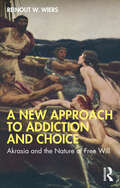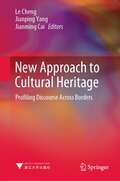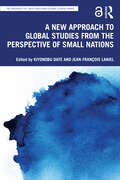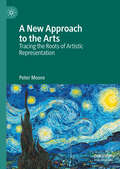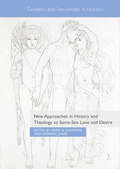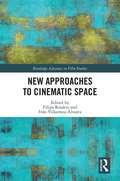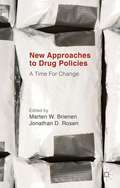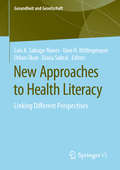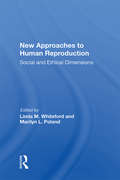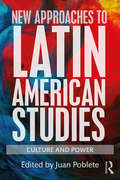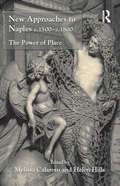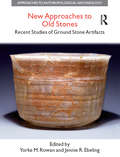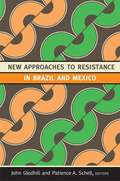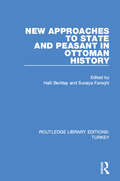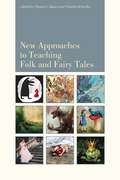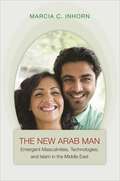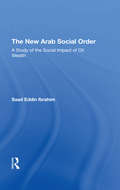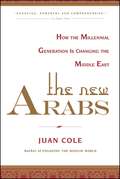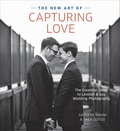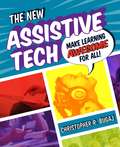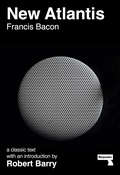- Table View
- List View
A New Anthropology of Islam
by John R. BowenIn this powerful, but accessible new study, John Bowen draws on a full range of work in social anthropology to present Islam in ways that emphasise its constitutive practices, from praying and learning to judging and political organising. Starting at the heart of Islam - revelation and learning in Arabic lands - Bowen shows how Muslims have adapted Islamic texts and traditions to ideas and conditions in the societies in which they live. Returning to key case studies in Asia, Africa and Western Europe, to explore each major domain of Islamic religious and social life, Bowen also considers the theoretical advances in social anthropology that have come out of the study of Islam. A New Anthropology of Islam is essential reading for all those interested in the study of Islam and for those following new developments in the discipline of anthropology.
A New Approach to Addiction and Choice: Akrasia and the Nature of Free Will
by Reinout W. WiersThis engaging book provides a novel examination of the nature of addiction, suggesting that by exploring akrasia—the tendency to act against one’s better judgement—we can better understand our addictive behaviors. It offers an alternative to the dominant biomedical model of addiction as a chronic brain disease by looking at the nature of how we make decisions and proposing the idea that biased choice is central to addiction.The book looks at both classic substance use disorders and newer “addictions” to smartphones, meat and fossil fuels. It discusses current perspectives on free will in philosophy, psychology and neuroscience, and the questions surrounding free will versus determinism, including our ability to steer our behaviors guided by the promise of future outcomes. Different perspectives on addiction and choice are presented in an eloquent style, and illustrated by personal stories. Through a lively discussion of the key scientific and philosophical issues surrounding addiction, this book is valuable for students in psychology, criminology, sociology and social work, as well as health care professionals and general readers interested in the nature of our free will.
New Approach to Cultural Heritage: Profiling Discourse Across Borders
by Le Cheng Jianping Yang Jianming CaiThis book addresses questions about theories of heritage, its methodologies of research, and where its boundaries lie with tourism, urban development, post-disaster recovery, collective identities, memory, or conflict. This book is a collection of heritage studies from a critical perspective as a product of the 2018 ACHS (Association of Critical Heritage Studies) Conference in Hangzhou, the largest conference of its kind in Asia. The contributors cover a wide spectrum of issues in heritage studies, such as heritage management, accessibility to heritage, heritage conservation and heritage policy, and heritage representation. It also examines the various contexts within which heritage emerges and how heritage is constructed within that context. Analyses are based on not only representations of heritage but also on the performativity. Explorations touch upon community involvement, landscape history, children’s literature, endangered food, architecture, advertisement, allotment garden, and gender and visual art. As heritage has always been a locus of contested verities, the book offers a variegated approach to heritage studies. It provides students and scholars new perspectives on heritage study.
A New Approach to Global Studies from the Perspective of Small Nations (The University of Tokyo-Routledge Global Studies Series)
by Kiyonobu Date Jean-François LanielWith emphasis on East Asian and North American examples – notably Japan and Quebec – Date, Laniel and their contributors take a new approach to the understanding of small nations and their role in the international system. Small nations, by their very nature, raise significant questions about what a nation is. Some small nations are sovereign states with relatively small populations and limited territory, others are nations within larger sovereign states, with distinctive cultures, governance structures or other features that differentiate them from their “parent” state. By focussing on non-European nations in particular, the contributors to this volume challenge our conceptions of what a small nation is and how it operates within the international system. They focus in particular on the nation-within-a-nation-state of Quebec and on Japan, supplemented by further examples from East Asia. By interrogating what these examples have to show us about the typology and character of small nations, they offer a critique of superpower and draw out the potential of small nation studies. A valuable resource for students and scholars of international relations and theories of the nation and nation state.
A New Approach to the Arts: Tracing the Roots of Artistic Representation
by Peter MooreThis book considers how art actually works, how the various art forms connect with the world of ordinary human experience. Many books approach the subject from the top down, through topics such as the nature of beauty, the meaning of art, aesthetic judgement, and so on. The present book examines the subject from the ground up, so to speak, showing how the creation and appreciation of art spring from innate human needs and capacities. What we call ‘the arts’ emerge organically from the habitual activities through which human beings represent the world to themselves and others. Artistic representation, always more than mere imitation, is a reaching for the spirit of a subject, a revealing of the implicit, a refreshing of the overly familiar. A key idea is that art is representation through convention – that artistic conventions, far from inhibiting the work of the artist, are vital to artistic creativity.
New Approaches in History and Theology to Same-Sex Love and Desire (Genders and Sexualities in History)
by Dominic Janes Mark D. ChapmanThis book offers a range of interdisciplinary evaluations of the history of same-sex relationships in the Church as they have been understood in different periods and contexts. The relationships between diverse forms of religious and sexual identities have been widely contested in the media since the rise of the lesbian and gay liberation movement in the 1970s. One of the key images that often appears in public debate is that of ‘lesbians and gays in the Church’ as a significant ‘problem’. Research over the past forty years or so into queer theology and the history of same-sex desire has shown that such issues have played an important role in the story of Christianity over many centuries. The contributors to this volume have all been inspired by the challenges of such revisionist study to explore religion and same-sex desire as a field of opportunity for investigation and debate. They uncover some of the hidden histories of the Church and its theologies: they tell sometimes unexpected stories, many of which invite serious further study. It is quite clear through history that some in the churches have been at the vanguard of legislative and social change. Similarly, some churches have offered safe queer spaces. Overall, these essays offer new interpretations and original research into the history of sexuality that helps inform the contemporary debate in the churches as well as in the academy.
New Approaches to African History: Women in Twentieth-Century Africa
by Iris BergerDuring a turbulent colonial and postcolonial century, African women struggled to control their own marital, sexual and economic lives and to gain a significant voice in local and national politics. This book introduces many remarkable women, who organized religious and political movements, fought in anti-colonial wars, ran away to escape arranged marriages, and during the 1990s began successful campaigns for gender parity in national legislatures. The book also explores the apparent paradox in the conflicting images of African women - as singularly oppressed and dominated by men, but also as strong, resourceful, and willing to challenge governments and local traditions to protect themselves and their families. Understanding the tension between women's power and their oppression, between their strength and their vulnerability, offers a new lens for understanding the relationship between the state and society in the twentieth century.
New Approaches to Cinematic Space (Routledge Advances in Film Studies)
by Filipa Rosário Iván Villarmea ÁlvarezNew Approaches to Cinematic Space aims to discuss the process of creation of cinematic spaces through moving images and the subsequent interpretation of their purpose and meaning. Throughout seventeen chapters, this edited collection will attempt to identify and interpret the formal strategies used by different filmmakers to depict real or imaginary places and turn them into abstract, conceptual spaces. The contributors to this volume will specifically focus on a series of systems of representation that go beyond the mere visual reproduction of a given location to construct a network of meanings that ultimately shapes our spatial worldview.
New Approaches to Drug Policies: A Time for Change
by Marten W. Brienen Jonathan D. RosenThe U. S. -led war on drugs has failed: drugs remain purer, cheaper and more readily available than when the war on drugs began in 1971. The drug war also has resulted in extreme levels of violence as drug traffickers and organized criminals compete for control of territory. Prohibitionist policies have destroyed the lives of millions of people as prisons warehouse drug offenders. This important volume represents an effort to map new approaches to drug policies. The contributors write from various disciplinary backgrounds and provide crucial insights on a wide-range of topics, including the gang-drug nexus, delinquency, legalization, trafficking, decriminalization, intervention programs and prison reform. This volume also provides a number of policy solutions and alternatives to the current drug strategies. Includes contributions from: Marten W. Brienen, Ted Galen Carpenter, Roger G. Dunham, Gregory Fulkerson, Betty Horwitz, Caitlin Elizabeth Hughes, Hanna Samir Kassab, Ana Maria Lobos, Bradford R. McGuinn, Fida Mohammad, Keri O'Neal, J. Bryan Page, Susan A. Phillips, Vanessa Rayan, Jonathan D. Rosen, Alex Stevens, Steven L. West, and Marcelo Rocha e Silva Zorovich.
New Approaches to European History: Europe after Empire
by Elizabeth BuettnerEurope after Empire is a pioneering comparative history of European decolonization from the formal ending of empires to the postcolonial European present. Elizabeth Buettner charts the long-term development of post-war decolonization processes as well as the histories of inward and return migration from former empires which followed. She shows that not only were former colonies remade as a result of the path to decolonization: so too was Western Europe, with imperial traces scattered throughout popular and elite cultures, consumer goods, religious life, political formations, and ideological terrains. People were also inwardly mobile, including not simply Europeans returning 'home' but Asians, Africans, West Indians, and others who made their way to Europe to forge new lives. The result is a Europe fundamentally transformed by multicultural diversity and cultural hybridity and by the destabilization of assumptions about race, culture, and the meanings of place, and where imperial legacies and memories live on.
New Approaches to Health Literacy: Linking Different Perspectives (Gesundheit und Gesellschaft)
by Orkan Okan Uwe H. Bittlingmayer Diana Sahrai Luis A. Saboga-NunesIn this anthology of health literacy, drawing on New Social Literacy studies and contemporary debates on equity, we discuss health literacy within German regional and cultural contexts as well as in selected non-European regions, such as in Asia and South America. Topics include unique reviews on health literacy, new empirical results on different population groups, in-depth ethnographic insights into social contexts, interventions intended to improve health literacy, and innovative theoretical dialogs. The discussions within this book provide new ideas and intriguing new results, also shedding light on the explanatory power of the health literacy concept as well as its boundaries.
New Approaches To Human Reproduction: Social And Ethical Dimensions
by Linda M. Whiteford Marilyn L. PolandThis book bridges the gap between cultural values and medical technology, focusing in the areas of conception, birth, and neonatality. It brings together research data and analysis particularly relevant for social scientists as well as nurses, public health professionals, and physicians.
New Approaches to Latin American Studies: Culture and Power
by Juan PobleteAcademic and research fields are moved by fads, waves, revolutionaries, paradigm shifts, and turns. They all imply a certain degree of change that alters the conditions of a stable system, producing an imbalance that needs to be addressed by the field itself. New Approaches to Latin American Studies: Culture and Power offers researchers and students from different theoretical fields an essential, turn-organized overview of the radical transformation of epistemological and methodological assumptions in Latin American Studies from the end of the 1980s to the present. Sixteen chapters written by experts in their respective fields help explain the various ways in which to think about these shifts. Questions posited include: Why are turns so crucial? How did they alter the shape or direction of the field? What new questions, objects, or problems did they contribute? What were or are their limitations? What did they displace or prevent us from considering? Among the turns included are: memory, transnational, popular culture, decolonial, feminism, affect, indigenous studies, transatlantic, ethical, post/hegemony, deconstruction, cultural policy, subalternism, gender and sexuality, performance, and cultural studies.
New Approaches to Naples c.1500-c.1800: The Power of Place
by Helen HillsEarly modern Naples has been characterized as a marginal, wild and exotic place on the fringes of the European world, and as such an appropriate target of attempts, by Catholic missionaries and others, to ’civilize’ the city. Historiographically bypassed in favour of Venice, Florence and Rome, Naples is frequently seen as emblematic of the cultural and political decline in the Italian peninsula and as epitomizing the problems of southern Italy. Yet, as this volume makes plain, such views blind us to some of its most extraordinary qualities, and limit our understanding, not only of one of the world's great capital cities, but also of the wider social, cultural and political dynamics of early modern Europe. As the centre of Spanish colonial power within Europe during the vicerealty, and with a population second only to Paris in early modern Europe, Naples is a city that deserves serious study. Further, as a Habsburg dominion, it offers vital points of comparison with non-European sites which were subject to European colonialism. While European colonization outside Europe has received intense scholarly attention, its cultural impact and representation within Europe remain under-explored. Too much has been taken for granted. Too few questions have been posed. In the sphere of the visual arts, investigation reveals that Neapolitan urbanism, architecture, painting and sculpture were of the highest quality during this period, while differing significantly from those of other Italian cities. For long ignored or treated as the subaltern sister of Rome, this urban treasure house is only now receiving the attention from scholars that it has so long deserved. This volume addresses the central paradoxes operating in early modern Italian scholarship. It seeks to illuminate both the historiographical pressures that have marginalized Naples and to showcase important new developments in Neapolitan cultural history and art history. Those developments showcased here include bot
New Approaches to Old Stones: Recent Studies of Ground Stone Artifacts (Approaches To Anthropological Archaeology Ser.)
by Yorke M. Rowan Jennie R. EbelingGround stone artefacts were widely used in food production in prehistory. However, the archaeological community has widely neglected the dataset of ground stone artefacts until now. 'New Approaches to Old Stones' offers a theoretical and methodological analysis of the archaeological data pertaining to ground stone tools. The essays draw on a range of case studies - from the Levant, Egypt, Crete, Anatolia, Mexico and North America - to examine ground stone technologies. From medieval Islamic stone cooking vessels and late Minoan stone vases, to the use of stone in ritual and as a symbol of luxury, 'New Approaches to Old Stones' offers a radical reassessment of the impact of ground-stone artefacts on technological change, production and exchange.
New Approaches to Resistance in Brazil and Mexico
by John Gledhill Patience A. SchellBringing together historically and ethnographically grounded studies of the social and political life of Brazil and Mexico, this collection of essays revitalizes resistance as an area of study. Resistance studies boomed in the 1980s and then was subject to a wave of critique in the 1990s. Covering the colonial period to the present day, the case studies in this collection suggest that, even if much of that critique was justified, resistance remains a useful analytic rubric. The collection has three sections, each of which is preceded by a short introduction. A section focused on religious institutions and movements is bracketed by one featuring historical studies from the sixteenth through the nineteenth centuries and another gathering more contemporary, ethnographically-based studies. Introducing the collection, the anthropologist John Gledhill traces the debates about resistance studies. In the conclusion, Alan Knight provides a historian's perspective on the broader implications of the contributors' findings.Contributors. Helga Baitenmann, Marcus J. M. de Carvalho, Guillermo de la Peña, John Gledhill, Matthew Gutmann, Maria Gabriela Hita, Alan Knight, Ilka Boaventura Leite, Jean Meyer, John Monteiro, Luis Nicolau Parés, Patricia R. Pessar, Patience A. Schell, Robert Slenes, Juan Pedro Viqueira, Margarita Zárate
New Approaches to State and Peasant in Ottoman History (Routledge Library Editions: Turkey #4)
by Suraiya Faroqhi Halil BerktayDebates on the world historical place of the Ottoman Empire in the last few decades have been conducted mainly in Turkey, but increasingly concepts have been introduced into the conversation from the study of European, Chinese and Central Asian history. This book, first published in 1992, examines the nature of the Ottoman state from a variety of perspectives, economic, political and social.
New Approaches to Teaching Folk and Fairy Tales
by Christa Jones Claudia SchwabeNew Approaches to Teaching Folk and Fairy Tales provides invaluable hands-on materials and pedagogical tools from an international group of scholars who share their experiences in teaching folk- and fairy-tale texts and films in a wide range of academic settings. This interdisciplinary collection introduces scholarly perspectives on how to teach fairy tales in a variety of courses and academic disciplines, including anthropology, creative writing, children’s literature, cultural studies, queer studies, film studies, linguistics, second language acquisition, translation studies, and women and gender studies, and points the way to other intermedial and intertextual approaches. Challenging the fairy-tale canon as represented by the Brothers Grimm, Charles Perrault, Hans Christian Andersen, and Walt Disney, contributors reveal an astonishingly diverse fairy-tale landscape. The book offers instructors a plethora of fresh ideas, teaching materials, and outside-the-box teaching strategies for classroom use as well as new and adaptable pedagogical models that invite students to engage with class materials in intellectually stimulating ways. A cutting-edge volume that acknowledges the continued interest in university courses on fairy tales, New Approaches to Teaching Folk and Fairy Tales enables instructors to introduce their students to a new, critical understanding of the fairy tale as well as to a host of new tales, traditions, and adaptations in a range of media. Contributors: Anne E. Duggan, Cyrille François, Lisa Gabbert, Pauline Greenhill, Donald Haase, Christa C. Jones, Christine A. Jones, Jeana Jorgensen, Armando Maggi, Doris McGonagill, Jennifer Orme, Christina Phillips Mattson, Claudia Schwabe, Anissa Talahite-Moodley, Maria Tatar, Francisco Vaz da Silva, Juliette Wood
The New Arab Man: Emergent Masculinities, Technologies, and Islam in the Middle East
by Marcia C. InhornMiddle Eastern Muslim men have been widely vilified as terrorists, religious zealots, and brutal oppressors of women. The New Arab Man challenges these stereotypes with the stories of ordinary Middle Eastern men as they struggle to overcome infertility and childlessness through assisted reproduction. Drawing on two decades of ethnographic research across the Middle East with hundreds of men from a variety of social and religious backgrounds, Marcia Inhorn shows how the new Arab man is self-consciously rethinking the patriarchal masculinity of his forefathers and unseating received wisdoms. This is especially true in childless Middle Eastern marriages where, contrary to popular belief, infertility is more common among men than women. Inhorn captures the marital, moral, and material commitments of couples undergoing assisted reproduction, revealing how new technologies are transforming their lives and religious sensibilities. And she looks at the changing manhood of husbands who undertake transnational "egg quests"--set against the backdrop of war and economic uncertainty--out of devotion to the infertile wives they love. Trenchant and emotionally gripping, The New Arab Man traces the emergence of new masculinities in the Middle East in the era of biotechnology.
The New Arab Social Order: A Study Of The Social Impact Of Oil Wealth
by Saad E. IbrahimThe skyrocketing Arab oil revenues of the 1970s have triggered tremendous socioeconomic forces in the Arab world. Observers have extensively studied the financial and geopolitical aspects of Arab oil, but generally have ignored the human and social repercussions stimulated by the oil wealth. This book challenges the commonly accepted view of the im
The New Arabs: How the Millennial Generation is Changing the Middle East
by Juan ColeRenowned blogger and Middle East expert Juan Cole takes us “inside the youth movements in Tunisia, Egypt, and Libya, showing us how activists used technology and social media to amplify their message and connect with like-minded citizens” (The New York Times) in this “rousing study of the Arab Spring” (Publishers Weekly, starred review).<P><P> For three decades, Cole has sought to put the relationship of the West and the Muslim world in historical context. In The New Arabs he has written “an elegant, carefully delineated synthesis of the complicated, intertwined facets of the Arab uprisings,” (Kirkus Reviews), illuminating the role of today’s Arab youth—who they are, what they want, and how they will affect world politics.<P> Not all big groups of teenagers and twenty-somethings necessarily produce historical movements centered on their identity as youth, with a generational set of organizations, symbols, and demands rooted at least partially in the distinctive problems of people their age. The Arab Millennials did. And, in a provocative, big-picture argument about the future of the Arab world, The New Arabs shows just how they did it. “Engaging, powerful, and comprehensive…The book feels as indispensable to scholars as it is insightful for a more casual reader” (Los Angeles Times).
The New Art History: A Critical Introduction
by Jonathan HarrisThe New Art History provides a comprehensive introduction to the fundamental changes which have occurred in both the institutions and practice of art history over the last thirty years. Jonathan Harris examines and accounts for the new approaches to the study of art which have been grouped loosely under the term 'the new art history'. He distinguishes between these and earlier forms of 'radical' or 'critical' analysis, explores the influence of other disciplines and traditions on art history, and relates art historical ideas and values to social change. Structured around an examination of key texts by major contemporary critics, including Tim Clarke, Griselda Pollock, Fred Orton, Albert Boime, Alan Wallach and Laura Mulvey, each chapter discusses a key moment in the discipline of art history, tracing the development and interaction of Marxist, feminist and psychoanalytic critical theories. Individual chapters include: * Capitalist Modernity, the Nation-State and Visual Representation * Feminism, Art, and Art History * Subjects, Identities and Visual Ideology * Structures and Meanings in Art and Society * The Representation of Sexuality
The New Art of Capturing Love
by Thea Dodds Kathryn HammThe first guide to posing and sensitively capturing same-sex couples on their big day, The New Art of Capturing Love equips semi-pro and professional wedding photographers to enter the exciting new LGBT wedding photography market.With nearly half of the states in the US (and 13 countries) currently recognizing same-sex partnerships, the market for LGBT weddings is poised for explosive growth, offering great opportunity for today's wedding photographers. But capturing portraits in this new market requires a new approach to posing, which until now has been nearly exclusively oriented toward pairing a larger man in black with a smaller woman in white. What works for Jack and Jill won't necessarily work for Jack and Michael, let alone Jill and Louise. The New Art of Capturing Loverewrites these traditional techniques, giving photographers the tools to create flattering, emotion-filled images for any couple in today's dynamic wedding market.
The New Assistive Tech: Make Learning Awesome For All!
by Christopher BurgajSchool districts often struggle to develop consistent practices for meeting the assistive needs of special education students. This playful yet professional book will help public school educators select, acquire and implement technology to help all students, but especially those with special needs. The New Assistive Tech is a catalyst for breaking down walls between special education and general education, and will help all educators realize they have tech knowledge (and can build upon that knowledge) that can be used to support students with disabilities. <p><p> This book: details how an educational team can request assistance to determine technology needs; explains how to conduct and document assessments to help an educational team make informed decisions about technology needs; describes a proactive approach to professional development for individuals and for those who train others on the use of technology; assists individuals or teams in creating an action plan for developing a culture of inclusion; and interweaves stories, songs and other exciting features to make learning fun!
New Atlantis and Selections from the Sylva Sylvarum
by Francis BaconFrancis Bacon's classic technological utopia brought to life for the modern sonic arts. In the early seventeenth century, at the very end of his life, the English statesman and philosopher Francis Bacon wrote a utopian fable called New Atlantis, containing an uncanny presentiment of twentieth-century electronic music. Now, four hundred years ago, music writer Robert Barry digs into the significance of that tale for the history of music, media, science and the senses. New Atlantis marked a significant turning point in the history of utopian literature -- not to mention the pre-history of science fiction, and even modern science itself. At the heart of the island paradise stumbled upon by Bacon's stranded sailors is a research institute called Bensalem where the locals practice "all sounds and their generation". The passage was sufficiently inspiring that Daphne Oram quoted it in full and pinned it to the wall of the newly opened BBC Radiophonic Workshop in 1957. Newly re-united with extracts from the Sylva Sylvarum, a notebook of real experiments that New Atlantis originally came bound with in the seventeenth century, this new publication seeks to bring Bacon's ideas to life for a new generation of artists and scholars engaged in the sonic arts, media archeology, and science studies. New Atlantis is presented with a brand new introduction by author and musician Robert Barry, which lays out the continuing relevance of Bacon's utopia for the place of sound and technology in the arts to this day.

